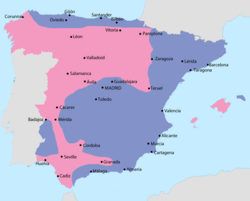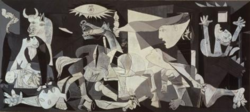
The Spanish Civil War was a conflict that was fought internally within Spain between 1936 and 1939. It occurred as a result of decades of political instability and economic and social crises in Spain. There were two sides of loosely aligned groups fighting the war; on one side were the Republicans, a coalition of democrats, socialists, and communists who leaned to the left politically and who wanted to preserve the Second Spanish Republic which had been established in 1931. They faced the Nationalists, a coalition of right-leaning conservatives and monarchists which had strong backing from within the Spanish military. The war would last nearly three years and became a proxy conflict in which Europe’s fascists and communists provided aid to different sides. Eventually, the Nationalists emerged victorious in the spring of 1939 and General Francisco Franco and the Falangist movement which he led established a military dictatorship which lasted for the next three and a half decades. The war led to the displacement of many people across Spain and the flight of half a million Republicans across the border to France in January and February 1939.[1]
Chronology of eventsChronology of events
In the sixteenth century, Spain had been the foremost political, economic and military power in Europe. Its vast overseas empire in the Americas included much of the Caribbean, Central America and South America and from this, it received enormous consignments of gold and silver bullion every year. This allowed Spain to become the superpower of the age. However, the bullion flow dried up in the seventeenth century and Spain was revealed for what it really was: a poor subsistence economy that couldn’t compete with emerging capitalist and colonial powers like Britain and the Dutch Republic. This rot continued into the eighteenth and nineteenth centuries, compounded by the loss of most of the empire in the Americas in the 1810s and 1820s. From there on, decades of political instability occurred, leading to changes in the political system on many occasions and repeated failures to reform the country.[2]
In 1931, King Alfonso XIII called national elections to try to allay domestic unrest, but these backfired on him and he was forced to abdicate and go into exile as a new republic, the Second Spanish Republic, was established. Yet it fared little better in trying to steady the ship of state, and in 1936 a military coup was launched by a group of powerful army commanders who had emerged as political figures during the Rif War in Morocco in the 1920s. This then morphed into the Spanish Civil War. Initially, this was led by Generals José Sanjurjo, Emilio Mola and Francisco Franco, but the deaths of both Sanjurjo and Mola in the summers of 1936 and 1937 left Franco in a position of leadership amongst the Nationalists.[3]
The conflict lasted for three years and became a theater in which the competing fascist and communist powers of Europe fought to create a new ally for their cause in Spain. The Soviet Union, for instance, aided the Republicans, while Nazi Germany and fascist Italy provided support to the Nationalists, notably in the shape of the Condor Legion from Germany which largely carried out the infamous bombing of Guernica in April 1937, during which this Basque town was levelled to the ground and many of the civilian inhabitants lost their lives. Eventually, through brutal measures like this, the Nationalists gained the upper hand, securing most of the north, west, and central parts of the country in 1936 and 1937, hemming the Republicans into two enclaves in Valencia and Catalonia. The final assaults on these regions occurred in 1938 and early 1939. As the Republicans neared defeat, a massive flight of Republican supporters over the Pyrenees into France took place.[4]

In the aftermath of the war, Franco established a military dictatorship, one which lasted down to the mid-1970s, though it became less oppressive from the 1950s onwards. Despite the aid which he had been provided with by Germany and Italy, Franco did not enter the Second World War on the side of the Axis and Spain maintained a qualified neutrality throughout the conflict.[5]
Extent of migrationExtent of migration
The flight of Spanish Republicans from Spain over the Pyrenees into southern France began following the fall of Barcelona to the Nationalists on the 26th of January, 1939. Over the space of just three weeks through to mid-February, it is estimated that around half a million Spaniards fled over the mountains along what became known as the Camí de la Retirada ("Path of the Retreat"). The event became known as La Retirada, ("the Retreat"). The French government’s response could hardly be characterized as welcoming and most of the 500,000 refugees were arrested and disarmed upon their arrival in southern France. They were then sent to internment camps on the beaches and in the towns of the region.[6]
Demographic impactDemographic impact
The demographic impact of La Retirada is difficult to fully assess. Although half a million Spanish Republicans migrated from Spain, these did not all go on to settle down in France. Many died in the appalling conditions in the internment camps in towns such as Saint Cyprien, where there was an inadequate supply of water and regular disease outbreaks. Approximately 200,000 were repatriated to Spain over the next 18 months as Franco’s regime made false promises that they would not be persecuted on their return. Of the quarter of a million or so that remained in France, many of the men were allowed to remain if they enlisted into the French Foreign Legion as France was preparing for war against Nazi Germany.[7]
When France fell to the Nazis in the early summer of 1940, the occupation government, and that of Vichy France in the south, set about identifying as many of the Spanish refugees as possible. Tens of thousands were sent to Germany as slave laborers, while approximately 15,000 were interred in the Nazi concentration camps as possible communists. A large proportion were sent to the Mauthausen concentration camp, where half of them died. Thus, while some of the refugees who arrived in southern France in the spring of 1939 managed to settle down and live out their lives in exile, the majority suffered greatly as a result of the inhumane response of the French government to their plight.[8] However, not all Spaniard Republicans went to France; it is estimated that over 22,000 migrated to Mexico[9] and smaller numbers to other Latin American countries like Argentina, Chile and the Dominican Republic.
See alsoSee also
Explore more about the Spanish heritageExplore more about the Spanish heritage
- Spanish historical records on MyHeritage
- Spanish Names: The Origins of Spanish Given Names and Surnames from the MyHeritage Blog
- Top 5 Resources to Expand Your Spanish Genealogical Research, webinar by Daniel Smith-Ramos on Legacy Family Tree Webinars
References
- ↑ The Spanish Civil War Between Two Other World Wars. TheCollector
- ↑ The Spanish Empire: Rise and Fall of a Great Power. Owlcation
- ↑ This Day In History: Spanish Civil War breaks out. History Channel
- ↑ Illustrated timeline of the Spanish Civil War (short). University of Warwick
- ↑ Francisco Franco. History Channel
- ↑ The painful past of Spanish Civil War refugees in France, 80 years on. France 24
- ↑ Franco refugees still haunted by the past: ‘We were cold, hungry and scared’. The Guardian
- ↑ SPANISH CIVIL WAR. United States Holocaust Memorial Museum
- ↑ Sánchez-Alonso, Blanca; Santiago-Caballero, Carlos. Spain’s Loss of Human Capital after the Civil War: Spanish Refugees in Mexico. The Journal of Interdisciplinary History (2022) 52 (4): 537–564.

